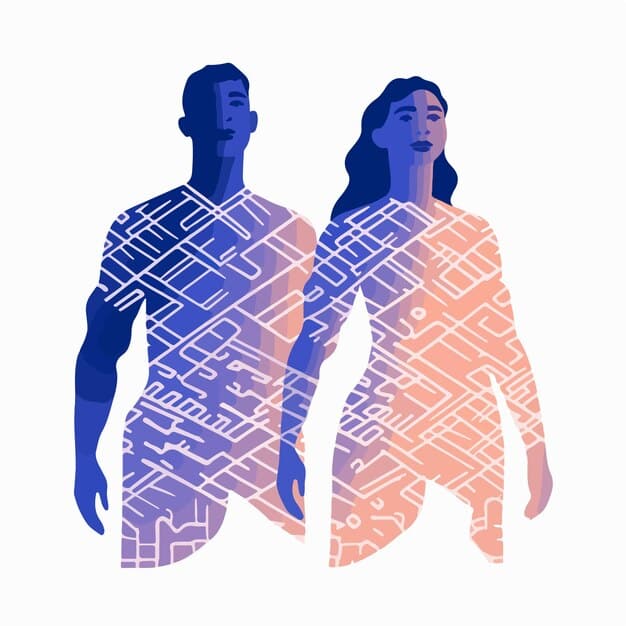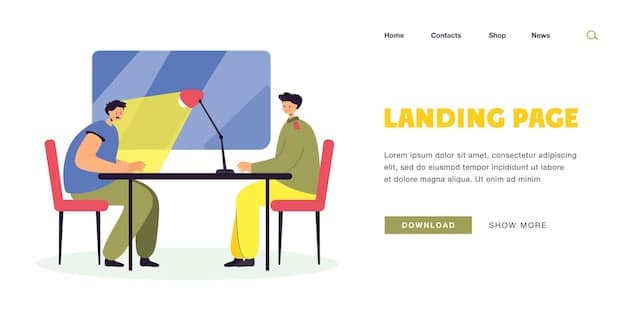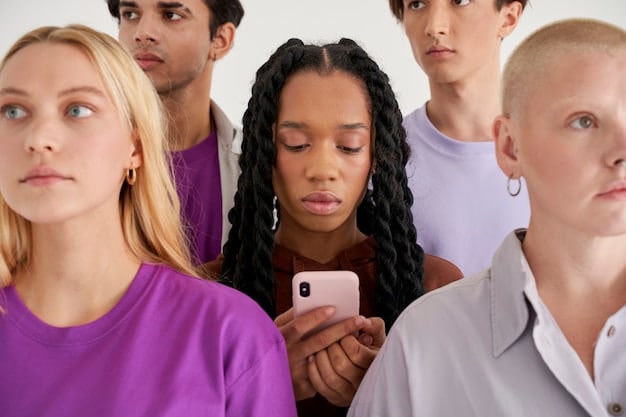Attribution Theory in Interpersonal Relationships 2025

The role of attribution theory in understanding interpersonal relationships in 2025 centers on how individuals explain behavior, influencing perceptions, conflicts, and trust within dynamic social connections shaped by evolving digital interactions and cultural shifts.
Understanding human connection in its nuanced complexity is a perpetual quest. As we navigate the intricate dance of modern relationships, the insights offered by attribution theory in understanding interpersonal relationships in 2025 become ever more critical. This framework helps us discern how we interpret the actions of others—and our own—shaping the very foundation of our social bonds.
The attributional lens: how we interpret behavior
At its core, attribution theory posits that individuals are driven to understand the causes of events and behaviors, both their own and others’. In 2025, amidst an increasingly interconnected yet often fragmented world, these explanations profoundly impact our interpersonal relationships. We are constantly making judgments, attributing actions to either internal (dispositional) factors like personality or external (situational) factors like circumstances.
Consider a friend who cancels plans last minute. Do you attribute their cancellation to their inherent unreliability (internal) or to an unforeseen emergency (external)? The answer to this question, often made in milliseconds, can drastically alter your emotional response and future interactions. This is the essence of the attributional process at play in daily life, intensified by rapid communication and diverse social contexts.
Fundamental attribution error in modern contexts
One of the most robust findings in attribution theory is the fundamental attribution error, or correspondence bias. This refers to our tendency to overemphasize internal, dispositional explanations for the behavior of others, while underestimating the impact of external, situational factors. In intimate relationships, this bias can lead to significant misunderstandings.
- Digital misinterpretations: The rise of text-based communication and social media often strips away crucial non-verbal cues. A brief, unenthusiastic reply to a message might be attributed to a partner’s lack of interest (internal) rather than their being in a rush or distracted (external).
- Workplace dynamics: A colleague’s perceived poor performance might be attributed to laziness rather than unmanageable workload or lack of resources, fostering resentment rather than empathy.
- Intercultural interactions: Different cultural norms around directness or emotional expression can lead to misattributions of character. What is seen as rude in one culture might be considered polite in another.
Conversely, for our own behavior, we often exhibit the actor-observer bias, attributing our successes to internal factors and our failures to external ones. This asymmetry, coupled with the fundamental attribution error, creates a complex web of misunderstandings that can strain any relationship, from romantic partnerships to professional collaborations. Recognizing these biases is the first step toward mitigating their negative effects in 2025.
The ubiquity of online profiles and digital personas further complicates these processes. We often form initial attributions based on curated online content, which may not reflect a person’s full reality, leading to confirmation biases when we eventually interact in person. Understanding these cognitive shortcuts is vital for cultivating more nuanced and empathetic interpretations of others’ actions, fostering stronger, more resilient relationships in the future.
Attributional styles and relationship satisfaction
Beyond isolated instances of attribution, individuals develop characteristic patterns of explaining events, known as attributional styles. These styles are consistently linked to both individual well-being and the health of interpersonal relationships. In 2025, as relational dynamics evolve, understanding these styles becomes even more pertinent for fostering positive connections.
Optimistic attributional styles, where positive events are attributed to internal, stable, and global causes, and negative events to external, unstable, and specific causes, tend to be associated with higher self-esteem and greater resilience. In relationships, these styles manifest as a tendency to give partners the ‘benefit of the doubt’.
Optimistic versus pessimistic attribution patterns
A partner with an optimistic attributional style, when faced with a minor disagreement, might attribute it to external stress or a momentary lapse in communication (optimistic). In contrast, a partner with a pessimistic style might attribute the same disagreement to the other’s inherent critical nature or disinterest (pessimistic). These differing interpretations directly impact how conflicts are managed and how much satisfaction each partner derives from the relationship.
- Relationship-enhancing attributions: In satisfied relationships, partners often make “relationship-enhancing attributions”—attributing positive partner behaviors to internal, stable, and global causes (e.g., “They’re so thoughtful to help me because they always are”) and negative behaviors to external, unstable, and specific causes (e.g., “They snapped because they had a bad day at work”).
- Distress-maintaining attributions: Conversely, in distressed relationships, partners tend to make “distress-maintaining attributions”—attributing positive behaviors to external, unstable factors (e.g., “They only did that to get something”) and negative behaviors to internal, stable, and global causes (e.g., “They’re always so selfish”).
The cumulative effect of these attributional patterns shapes the emotional climate of a relationship. A constant stream of negative attributions can erode trust and intimacy, fostering a cycle of blame and defensiveness. In the digital age, where interactions are often less rich in contextual cues, the potential for misattribution and the reinforcement of negative attributional styles is amplified.
Promoting awareness of these styles and encouraging a more charitable interpretation of others’ actions can significantly improve relationship satisfaction. This involves consciously challenging initial negative attributions and seeking alternative, more benign explanations, a skill increasingly valuable in the intricate world of 2025 interpersonal dynamics.
Attribution and conflict resolution
Conflict is an inevitable part of any interpersonal relationship. How individuals explain the causes of conflict, and the motivations behind a partner’s contentious behavior, is fundamental to whether the conflict is resolved constructively or escalates into damaging disputes. In 2025, with diverse social pressures and communication methods, attribution theory provides a crucial framework for navigating these challenges.
If one partner attributes a conflict to the other’s character flaws (internal attribution), the stage is set for blame and defensiveness. However, if the conflict is attributed to external stressors or temporary misunderstandings (external attribution), there is greater room for empathy, problem-solving, and a focus on resolution rather than recrimination.

The attributional cycle of conflict and repair
Understanding the role of attribution in conflict resolution helps unravel the complexities of relational dynamics. The way we interpret a partner’s intentions during a disagreement significantly impacts our emotional response and willingness to engage in repair attempts.
For example, if a partner feels their input is being ignored, they might attribute this to the other’s dismissiveness. This internal attribution (“They don’t value my opinion”) can lead to feelings of resentment and withdrawal. If, however, they consider that their partner might be preoccupied or genuinely overwhelmed (an external attribution), their response is more likely to be one of concern and patience.
Key to effective conflict resolution is the ability to engage in attributional retraining—consciously challenging maladaptive attributional biases. This involves:
- Perspective-taking: Actively trying to see the situation from the other person’s point of view, considering alternative explanations for their behavior.
- Seeking clarification: Rather than assuming, asking open-ended questions to understand the circumstances, intentions, and feelings of the other person.
- Focusing on behaviors, not traits: Instead of saying, “You are always so inconsiderate,” focusing on specific behaviors: “When you did X, I felt Y.”
In 2025, where communication often occurs across digital platforms, the absence of non-verbal cues (tone of voice, facial expressions) makes accurate attribution even more challenging. Misunderstandings proliferate easily. Therefore, fostering deliberate, empathetic communication and a willingness to explore alternative attributions is paramount for healthy conflict resolution and sustaining robust interpersonal relationships.
The ability to shift from dispositional to situational attributions during conflict is a marker of relational maturity and directly contributes to a relationship’s resilience. It allows partners to approach disagreements as shared problems to be solved, rather than personal attacks to be defended against, thereby strengthening their bond over time.
Attribution and trust building in relationships
Trust is the bedrock of any meaningful interpersonal relationship, and attribution theory offers profound insights into its development and erosion. The explanations we form for a partner’s consistent actions, particularly those demonstrating reliability and benevolence, directly contribute to the foundation of trust. In 2025, where relationships might be spread across geographical distances or rely heavily on digital interactions, the dynamics of trust building through attribution are critical.
When a partner consistently behaves in a way that suggests their commitment, honesty, and care, and these behaviors are attributed to stable, internal characteristics (e.g., “They are a genuinely kind and dependable person”), trust is strengthened. Conversely, if positive actions are attributed to external or fleeting reasons (e.g., “They are only doing this because they have to”), trust remains fragile or fails to develop fully.
Developing durable trust through consistent attribution
The process of trust building is deeply tied to our attributions of a partner’s motives. Consider an instance where a partner goes out of their way to support you during a difficult time. If you attribute this to their inherent caring nature and deep commitment to your well-being, your trust in them solidifies. If, however, you attribute it to a desire to avoid conflict or to gain something in return, trust will not only falter but may actively erode.
- Consistency in positive attributions: Repeated experiences of a partner’s positive actions, consistently attributed to their good intentions and stable character, build a robust reservoir of trust.
- Impact of negative attributions: A single act of betrayal, if attributed to deeply ingrained malicious intent, can severely damage or destroy trust, even if subsequent positive actions occur.
- Repairing trust: When trust is broken, repair often hinges on the offending party’s ability to provide an attribution for their behavior that is perceived as sincere, external, and controllable (e.g., “I made a mistake because I was under immense stress, and I will ensure it doesn’t happen again” vs. “I did it because I’m just a bad person”).
In modern relationships, the challenge of building trust is compounded by the ease of miscommunication and the potential for context collapse in digital spaces. A misinterpreted text message or a perceived slight on social media can trigger negative attributions quickly. The speed at which information spreads, or is withheld, online can also impact the attributional process, making it harder to discern true intentions.
Therefore, nurturing trust in 2025 requires not only consistent trustworthy behavior but also transparent communication that helps partners make accurate, benevolent attributions. Openly discussing motivations, acknowledging impact, and offering clear explanations for actions are proactive steps that leverage attribution theory to foster deeper, more resilient trust within relationships.
Cultural nuances and digital layers in attribution
In 2025, the application of attribution theory to interpersonal relationships must account for two increasingly dominant factors: cultural nuances and the pervasive digital layer. While the basic human tendency to seek explanations for behavior remains universal, the specific ways these attributions are formed and expressed vary significantly across cultures and are heavily influenced by online environments.
Individualistic cultures, prevalent in the United States and Western Europe, tend to emphasize personal agency and internal attributions. This means individuals in these cultures are more likely to attribute behavior to personality traits or individual choices. In contrast, collectivistic cultures, common in many Asian, African, and Latin American societies, place a greater emphasis on group harmony, social context, and external factors. Here, behavior is more often attributed to situational pressures, social roles, or group norms.
This difference in attributional style can lead to significant misunderstandings in cross-cultural interpersonal relationships. For instance, a direct, assertive communication style, internally attributed as confident in an individualistic culture, might be externally attributed as rude or disrespectful in a collectivistic one.

The digital dimension of attribution in 2025
The digital realm adds another layer of complexity. Online interactions often lack the rich non-verbal cues (tone of voice, facial expressions, body language) that help us make accurate attributions in face-to-face communication. This ambiguity can lead to:
- Increased fundamental attribution error: Without visual and auditory context, it’s easier to jump to conclusions about someone’s character based on a brief text or post, rather than considering their situation.
- Echo chambers and confirmation bias: Social media algorithms can create “echo chambers” where individuals are primarily exposed to content that confirms their existing biases, reinforcing certain attributions (e.g., negative attributions about an out-group).
- Curated selves: The ability to curate one’s online persona can lead to misattributions of authenticity. A carefully constructed profile might lead others to attribute qualities that aren’t fully present in real life, setting up potential disappointment and re-attribution later.
In 2025, navigating interpersonal relationships effectively requires an acute awareness of these cultural and digital influences on attribution. This means practicing cultural humility, actively seeking external explanations for behavior, and engaging in more deliberate, context-rich communication, especially in mediated interactions. Recognizing that others may interpret the same action through a different cultural or digital lens is paramount for fostering empathy and building robust global connections.
Furthermore, the rapid evolution of AI and virtual reality technologies could further complicate attribution. Virtual avatars and AI-generated responses might blur the lines between human and machine behavior, raising complex questions about how we attribute intent and responsibility in increasingly hybrid interactions. The ability to critically analyze and adapt our attributional processes will be a key skill for maintaining authentic relationships in the coming years.
Educational and therapeutic applications
Given the profound influence of attribution on interpersonal relationships, understanding its mechanisms has significant implications for educational programs and therapeutic interventions in 2025. Leveraging attribution theory can empower individuals to develop healthier relational patterns and resolve conflicts more effectively.
In educational settings, teaching students about attribution biases—such as the fundamental attribution error and actor-observer bias—can foster greater empathy and reduce prejudice. By understanding that “people do what they do because of who they are *and* because of the situation they are in,” individuals can develop a more nuanced understanding of human behavior.
Practical applications for cultivating healthier relationships
Therapeutic interventions, particularly those focused on couples counseling or family therapy, frequently draw upon attribution theory. Techniques often aim to shift maladaptive attributional styles that contribute to relational distress. This involves:
- Challenging distress-maintaining attributions: Therapists guide individuals and couples to question negative assumptions about a partner’s motives and consider alternative, more benevolent explanations. For example, instead of “My partner always criticizes me,” considering “My partner might be stressed and expressing it poorly.”
- Promoting relationship-enhancing attributions: Encouraging partners to attribute positive behaviors to internal, stable reasons (“They did that because they truly care”) and negative behaviors to external, unstable reasons (“They made a mistake because they were having a bad day”).
- Developing meta-attributional awareness: Helping individuals become aware of their own attributional processes—how they typically explain events—and the impact these explanations have on their emotions and behavior. This self-awareness is crucial for initiating change.
In 2025, with increasing reliance on telemedicine and digital therapy platforms, these principles remain vital. Therapists can use digital tools to help clients track their attributions, identify patterns, and practice reframing. Educational apps and online courses could also be developed to teach these psychological concepts in an accessible way, reaching a wider audience interested in improving their relationship skills.
Furthermore, workshops on team building and inter-group relations in professional settings can benefit from attributional training. By explicitly discussing predictable biases, organizations can cultivate more collaborative environments, reduce internal conflicts, and enhance overall productivity. The power of attribution theory lies in its ability to offer concrete strategies for reframing perspectives and, consequently, transforming relationships at individual, interpersonal, and societal levels, making it increasingly indispensable in our evolving social landscape.
| Key Aspect | Brief Description |
|---|---|
| 🤔 Fundamental Error | Over-attributing others’ behavior to character, underestimating situation. |
| 💞 Relationship Styles | Optimistic vs. pessimistic views of partner actions affecting satisfaction. |
| 🤝 Conflict Resolution | Attributions shape whether conflict leads to blame or problem-solving. |
| 🌐 Digital & Culture | Online contexts and cultural norms significantly alter attribution processes. |
FAQs about attribution theory in relationships 2025
▼
Attribution theory explains how individuals interpret the causes of events and behaviors. In 2025, it’s crucial as digital communication and diverse social contexts amplify potential misunderstandings. Understanding whether we attribute actions to internal traits or external situations helps navigate relationships more effectively, fostering empathy and reducing conflict in an increasingly complex world.
▼
The fundamental attribution error leads us to overemphasize personality traits (internal factors) rather than situational context (external factors) when explaining others’ behavior. In modern relationships, especially online, this can cause misinterpretations, like assuming a partner’s brief text signals disinterest rather than them simply being busy, leading to unnecessary conflict or strained dynamics.
▼
Yes, by promoting “attributional retraining.” This involves consciously challenging negative attributions and seeking more empathetic explanations for a partner’s behavior during conflict. Instead of blaming someone’s character for a disagreement, considering situational factors allows for problem-solving rather than escalating blame, fostering healthier communication and repair attempts.
▼
Digital interactions, lacking rich non-verbal cues, often increase ambiguity, making accurate attributions harder. Text-based communication or curated online personas can lead to rapid, often negative, attributions about intent or character. This highlights the need for deliberate communication and seeking clarification in digital spaces to avoid misinterpretations and maintain authentic connections.
▼
Recognizing your and your partner’s default “attributional style” (optimistic or pessimistic) is key. Optimistic styles attribute positive events to stable traits and negative events to temporary situations, fostering relationship-enhancing views. Awareness allows couples to work towards more positive, compassionate interpretations of each other’s actions, leading to increased trust and overall relationship satisfaction.
Conclusion
As we navigate the complexities of interpersonal relationships in 2025, attribution theory stands as an indispensable framework. Its insights into how we interpret both our own behaviors and those of others illuminate the intricate cognitive processes that underpin trust, resolve conflict, and sustain connection. By raising awareness of our inherent attributional biases, particularly the fundamental attribution error and our individual styles, we can cultivate greater empathy, challenge harmful assumptions, and actively choose more benevolent interpretations. In an era shaped by cultural diversity and pervasive digital communication, embracing the principles of attribution theory offers a robust pathway towards building more resilient, understanding, and ultimately more fulfilling human relationships.





